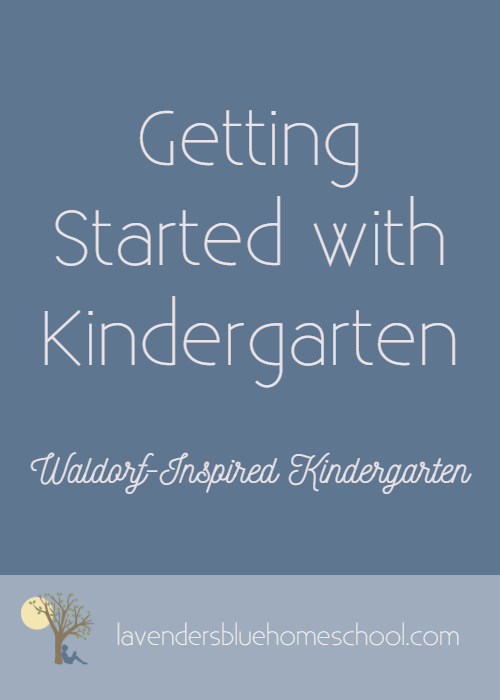Getting Started with Kindergarten
Waldorf-inspired homeschooling offers a unique perspective on education in early childhood. In this approach, young children are respected as whole persons and their healthy development is the top priority. We don’t rush early childhood but instead we take the long-game seriously. We do the right things at the right time (instead of more! now! sooner!) in order to lay a foundation for joyful life-long learning.
If you’re new to this, you might be wondering...what are those right things at the right time? If we’re not jumping on the “workbooks for 4-year-olds and phonics video games for 5-year-olds” bandwagon, what is it that we do for kindergarten instead?
The Lavender’s Blue blog is full of resources on early childhood and kindergarten but you may be wondering where to dive in. Today’s post is your guide to getting started with kindergarten! I’ll take you step by step from understanding the essentials through adding activities such as handwork.
Now a word of caution! You may be tempted to skip ahead to “Step 4” which is full of tangible activities and things to do. But there’s a reason that step comes last on our list. Until you have established a home in which rhythm, connection, play, and movement are the priority, adding in new activities misses the point.
I encourage you to start from the beginning, bookmark this page, and take your time going through it. You can read one step or one linked article at a time. There’s no rushed learning in kindergarten, and that means for you too, mama!
Step 1: Understand the Essentials of Kindergarten
What does it mean to homeschool kindergarten with Waldorf-inspired methods? It means allowing children the time and space for a childhood full of active play, imagination, and a strong connection to home and family. Your role as the parent is to create the family environment your child needs in order to do his most important job - learning through play. Read all about the Essentials of Kindergarten here!
In the Waldorf approach, we often talk about the early years and the kindergarten years (plural!), with no hard-and-fast distinction between them. To understand the timing of kindergarten, the difference between kindy and the early years, and when to move on to first grade, read this article on When should we start kindergarten? here.
Step 2: Understand How to Encourage Healthy Play
Play is paramount for healthy development and learning in early childhood! One of the best things you can do for your kindergarten child is to protect the time and space he needs to play. So what does healthy, creative play look like? How do you encourage play, and what is your role as the homeschool parent?
Here are the top five things you can do to establish play as the priority in kindergarten:
Step 3: Create a Rhythm for Your Family
I fell in love with the Waldorf approach when I discovered the concept of rhythm. I knew the importance of the freedom to play in childhood but I also saw that something was off for children who had no structure in their days. True freedom requires form - otherwise you have chaos, overstimulation, and anxiety. Have you ever noticed that many very creative and successful writers, thinkers, artists, and scientists have created highly structured lives for themselves? Rhythm is the safe, predictable container that allows for imaginative, creative play. Here’s how to craft a Rhythm in the Kindy Years.
Step 4: Explore the World of Story, Song, and Artistic Play
When you’re ready, you can begin exploring the beautiful world of story, song, and artistic work. These activities don’t replace the essentials of rhythm, play, connection, and movement in kindergarten! They are meant to complement the healthy rhythms of your home and nurture imaginative play. In other words, if you’ve covered steps 1 through 3, you’re already doing kindergarten “right.” But when you’re ready to put icing on your cake, here are some delicious ways to do that!
Start by telling stories and singing songs. These are wonderful activities to add to your daily rhythm. Stories and songs will inspire your child’s creative play, nurture language skills, and build capacities for literacy, memory, musicality, and more. In Waldorf-inspired kindergarten, we boost these benefits with repetition - by telling the same story and singing the same songs many days in a row. In this way, your child learns the stories and songs, they live in her and become part of her play. Read all about Getting Started with Storytelling here. For songs to sing, check out the Circle Time Resources page or join the Sing More Challenge here.
Next consider what artistic, movement, or practical activities you might like to include as part of your weekly rhythm. There are many possibilities for kindergarten, so choose activities that you and your children enjoy! The post on Rhythm in the Kindy Years (above) will give you ideas for healthy activities, and there are articles on the blog to help you get started with Waldorf-style painting, modeling, and handwork. Remember that you can layer activities in one at a time.
That’s It!
When you get this far, you’re not just getting started, you’re doing it and I’m cheering you on! And if you need more guidance, I would love to support you and your family along your homeschooling journey. The Lavender’s Blue Kindergarten Curriculum is designed to take the planning burden off of you so you can focus on your family. It includes lovely stories, circle times, and artistic activities all integrated into detailed weekly lesson plans as well as video tutorials on wet-on-wet watercolor painting, beeswax modeling, and storytelling!
I’m wishing you ALL the best for your kindergarten years and beyond!

